Artificial Intelligence: Goals, Utilization, and Responsible AI Report
VerifiedAdded on 2023/01/16
|24
|7006
|89
Report
AI Summary
This report provides a comprehensive overview of artificial intelligence (AI), exploring its goals, objectives, and various applications across different business sectors. It delves into the core concepts of AI, including machine learning, machine intelligence, and machine consciousness, and examines how these technologies are transforming industries. The report discusses knowledge representation, reasoning, automated planning, natural language processing, computer vision, and robotics as key components of AI. It also highlights the importance of responsible AI practices, addressing ethical considerations and the need for careful monitoring of AI systems. Furthermore, the report outlines AI implementation strategies and assesses AI maturity, offering insights into the potential benefits and challenges associated with this rapidly evolving field. The report emphasizes the transformative power of AI and its potential to impact society, emphasizing the need for a balanced approach to its development and deployment. Finally, the report covers the goals of AI which includes the exponential intelligence explosion and the creation of a smart, mechanized, and intellectually globally networked being.
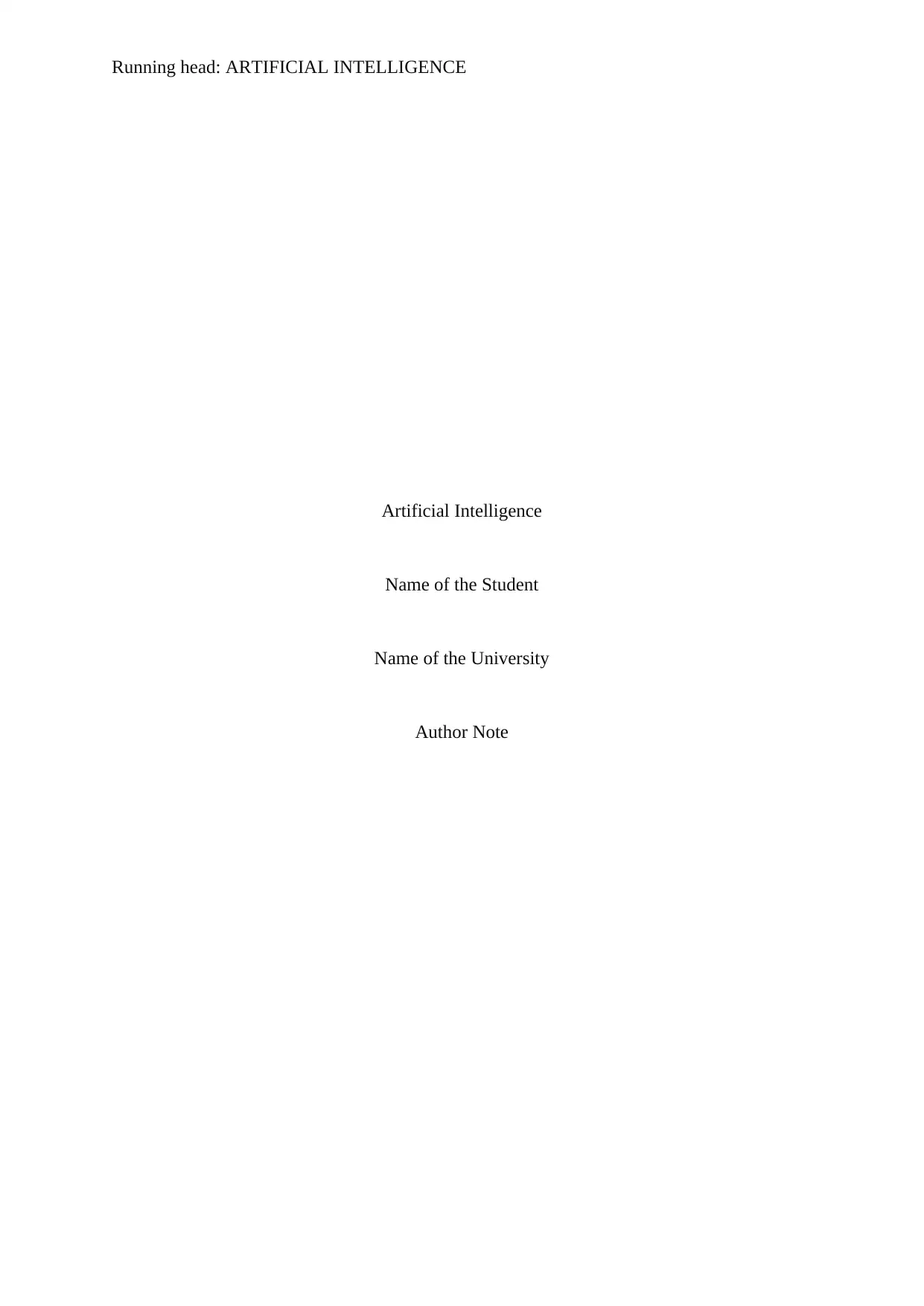
Running head: ARTIFICIAL INTELLIGENCE
Artificial Intelligence
Name of the Student
Name of the University
Author Note
Artificial Intelligence
Name of the Student
Name of the University
Author Note
Paraphrase This Document
Need a fresh take? Get an instant paraphrase of this document with our AI Paraphraser
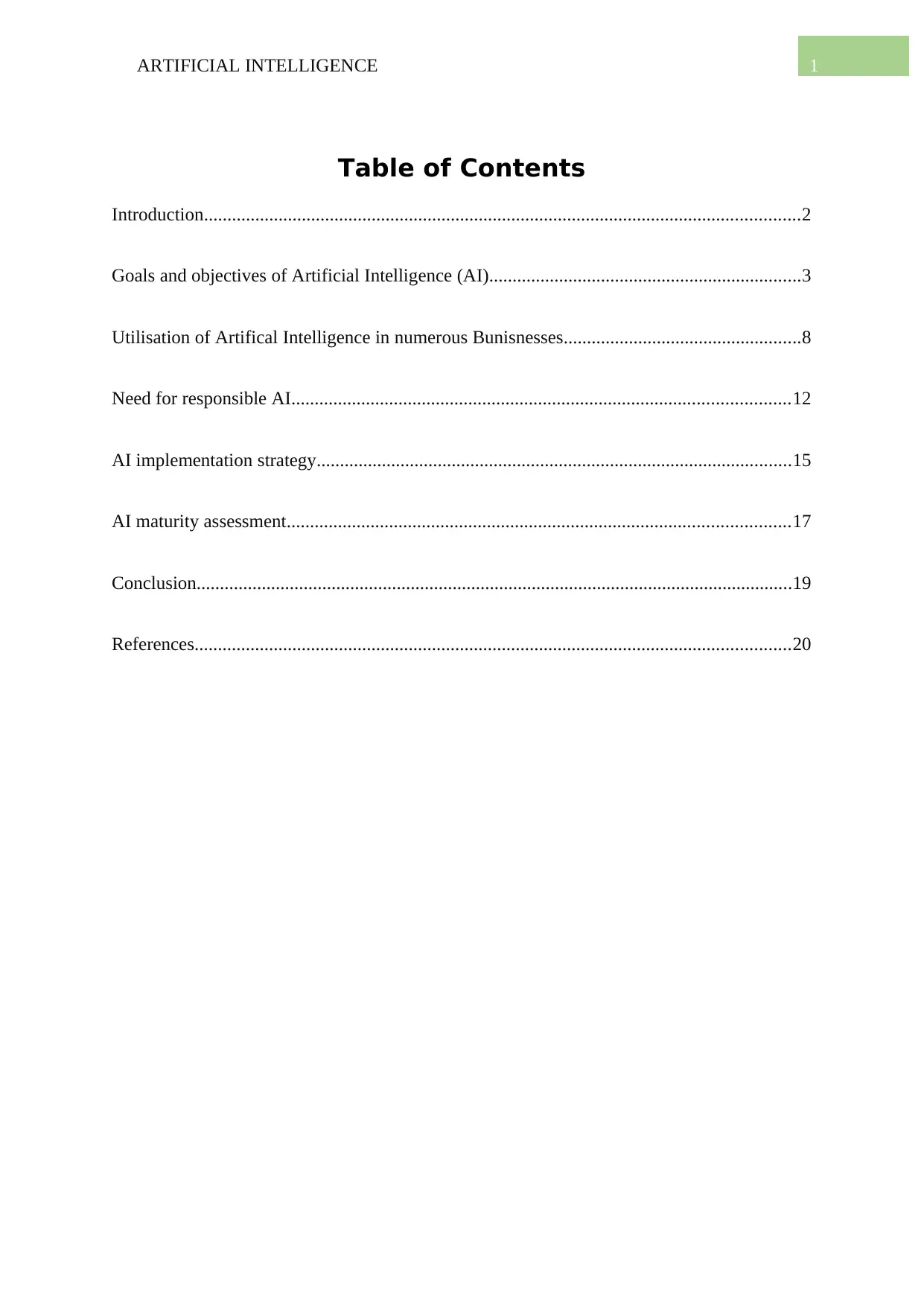
1ARTIFICIAL INTELLIGENCE
Table of Contents
Introduction................................................................................................................................2
Goals and objectives of Artificial Intelligence (AI)...................................................................3
Utilisation of Artifical Intelligence in numerous Bunisnesses...................................................8
Need for responsible AI...........................................................................................................12
AI implementation strategy......................................................................................................15
AI maturity assessment............................................................................................................17
Conclusion................................................................................................................................19
References................................................................................................................................20
Table of Contents
Introduction................................................................................................................................2
Goals and objectives of Artificial Intelligence (AI)...................................................................3
Utilisation of Artifical Intelligence in numerous Bunisnesses...................................................8
Need for responsible AI...........................................................................................................12
AI implementation strategy......................................................................................................15
AI maturity assessment............................................................................................................17
Conclusion................................................................................................................................19
References................................................................................................................................20
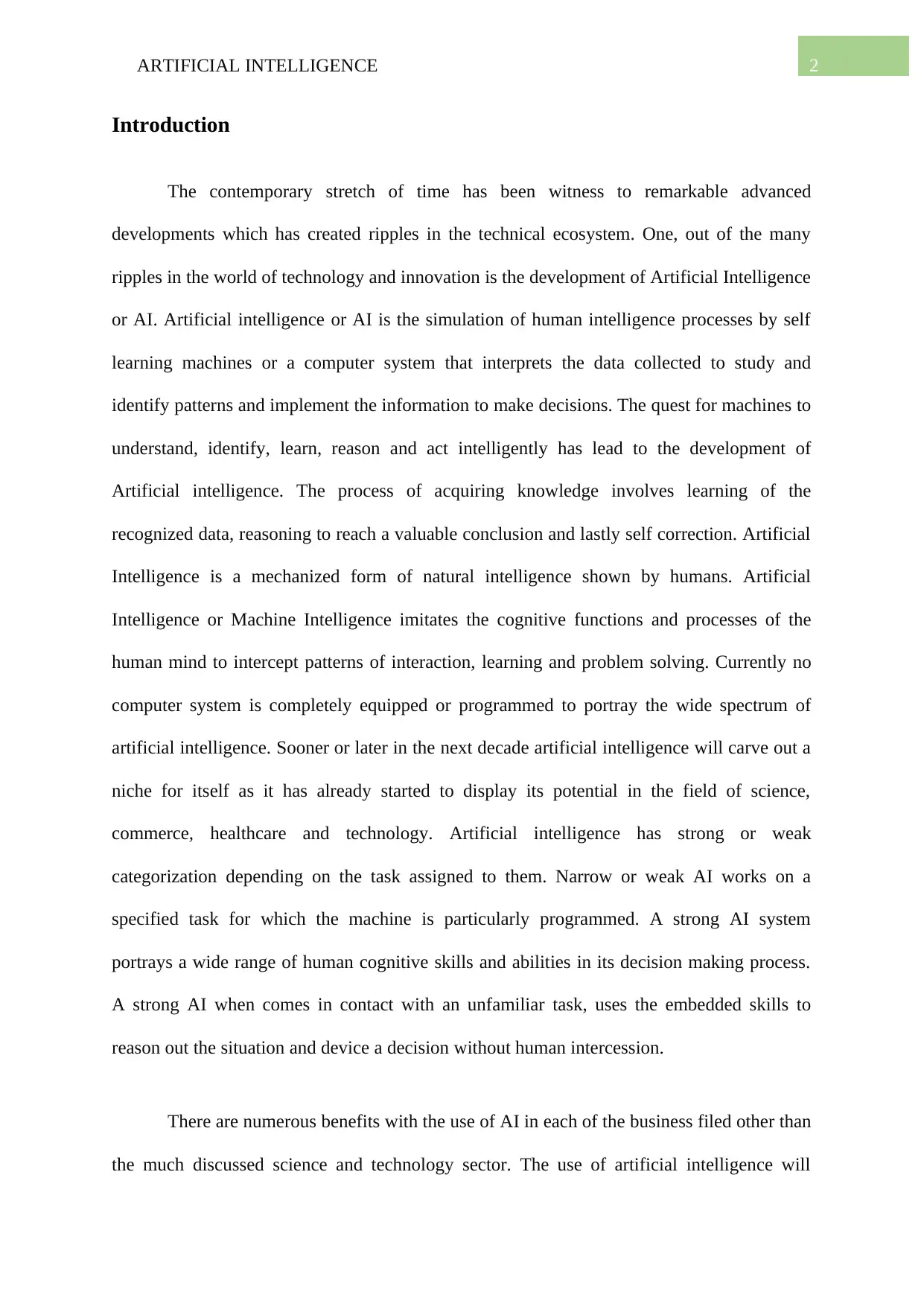
2ARTIFICIAL INTELLIGENCE
Introduction
The contemporary stretch of time has been witness to remarkable advanced
developments which has created ripples in the technical ecosystem. One, out of the many
ripples in the world of technology and innovation is the development of Artificial Intelligence
or AI. Artificial intelligence or AI is the simulation of human intelligence processes by self
learning machines or a computer system that interprets the data collected to study and
identify patterns and implement the information to make decisions. The quest for machines to
understand, identify, learn, reason and act intelligently has lead to the development of
Artificial intelligence. The process of acquiring knowledge involves learning of the
recognized data, reasoning to reach a valuable conclusion and lastly self correction. Artificial
Intelligence is a mechanized form of natural intelligence shown by humans. Artificial
Intelligence or Machine Intelligence imitates the cognitive functions and processes of the
human mind to intercept patterns of interaction, learning and problem solving. Currently no
computer system is completely equipped or programmed to portray the wide spectrum of
artificial intelligence. Sooner or later in the next decade artificial intelligence will carve out a
niche for itself as it has already started to display its potential in the field of science,
commerce, healthcare and technology. Artificial intelligence has strong or weak
categorization depending on the task assigned to them. Narrow or weak AI works on a
specified task for which the machine is particularly programmed. A strong AI system
portrays a wide range of human cognitive skills and abilities in its decision making process.
A strong AI when comes in contact with an unfamiliar task, uses the embedded skills to
reason out the situation and device a decision without human intercession.
There are numerous benefits with the use of AI in each of the business filed other than
the much discussed science and technology sector. The use of artificial intelligence will
Introduction
The contemporary stretch of time has been witness to remarkable advanced
developments which has created ripples in the technical ecosystem. One, out of the many
ripples in the world of technology and innovation is the development of Artificial Intelligence
or AI. Artificial intelligence or AI is the simulation of human intelligence processes by self
learning machines or a computer system that interprets the data collected to study and
identify patterns and implement the information to make decisions. The quest for machines to
understand, identify, learn, reason and act intelligently has lead to the development of
Artificial intelligence. The process of acquiring knowledge involves learning of the
recognized data, reasoning to reach a valuable conclusion and lastly self correction. Artificial
Intelligence is a mechanized form of natural intelligence shown by humans. Artificial
Intelligence or Machine Intelligence imitates the cognitive functions and processes of the
human mind to intercept patterns of interaction, learning and problem solving. Currently no
computer system is completely equipped or programmed to portray the wide spectrum of
artificial intelligence. Sooner or later in the next decade artificial intelligence will carve out a
niche for itself as it has already started to display its potential in the field of science,
commerce, healthcare and technology. Artificial intelligence has strong or weak
categorization depending on the task assigned to them. Narrow or weak AI works on a
specified task for which the machine is particularly programmed. A strong AI system
portrays a wide range of human cognitive skills and abilities in its decision making process.
A strong AI when comes in contact with an unfamiliar task, uses the embedded skills to
reason out the situation and device a decision without human intercession.
There are numerous benefits with the use of AI in each of the business filed other than
the much discussed science and technology sector. The use of artificial intelligence will
⊘ This is a preview!⊘
Do you want full access?
Subscribe today to unlock all pages.

Trusted by 1+ million students worldwide
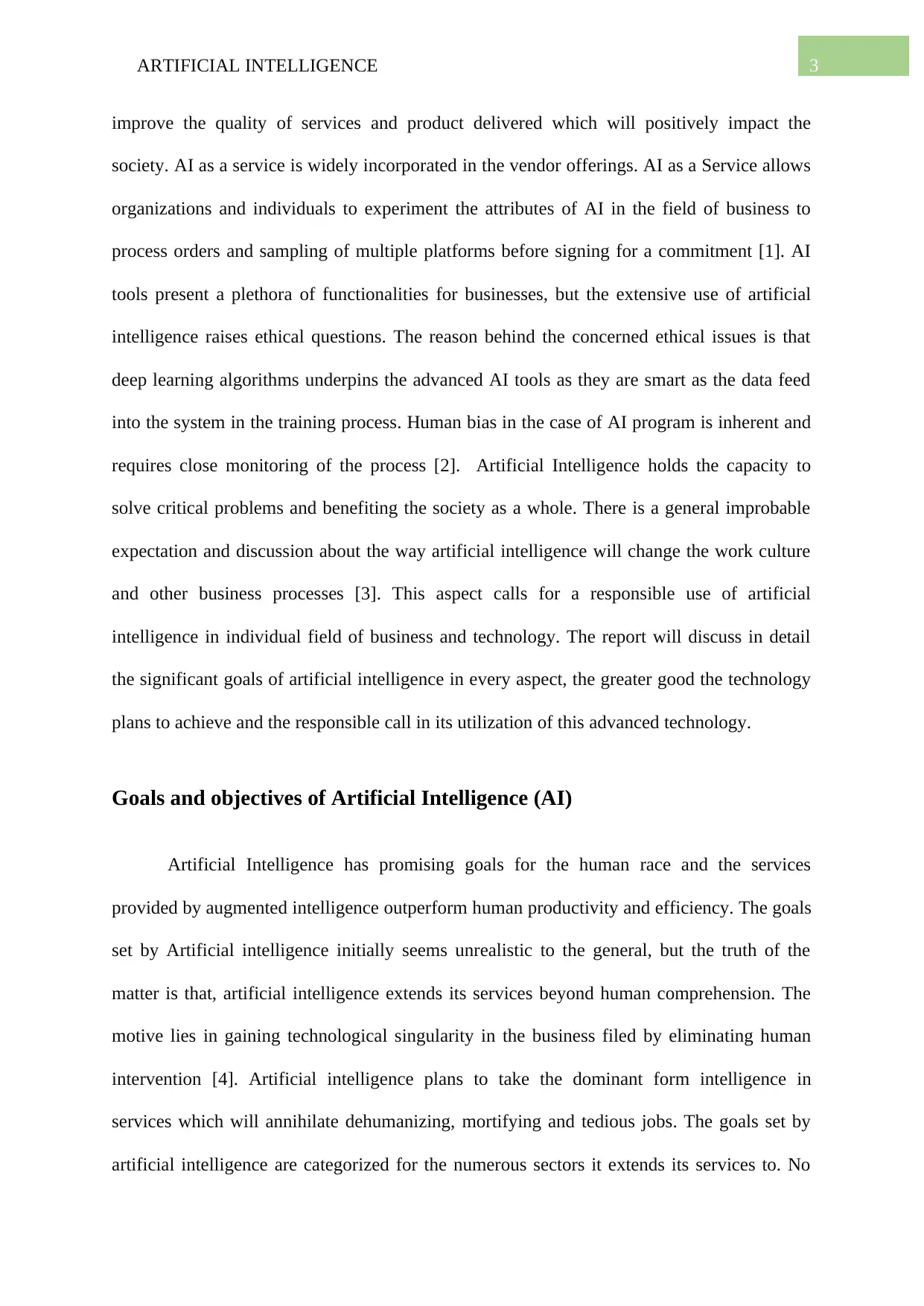
3ARTIFICIAL INTELLIGENCE
improve the quality of services and product delivered which will positively impact the
society. AI as a service is widely incorporated in the vendor offerings. AI as a Service allows
organizations and individuals to experiment the attributes of AI in the field of business to
process orders and sampling of multiple platforms before signing for a commitment [1]. AI
tools present a plethora of functionalities for businesses, but the extensive use of artificial
intelligence raises ethical questions. The reason behind the concerned ethical issues is that
deep learning algorithms underpins the advanced AI tools as they are smart as the data feed
into the system in the training process. Human bias in the case of AI program is inherent and
requires close monitoring of the process [2]. Artificial Intelligence holds the capacity to
solve critical problems and benefiting the society as a whole. There is a general improbable
expectation and discussion about the way artificial intelligence will change the work culture
and other business processes [3]. This aspect calls for a responsible use of artificial
intelligence in individual field of business and technology. The report will discuss in detail
the significant goals of artificial intelligence in every aspect, the greater good the technology
plans to achieve and the responsible call in its utilization of this advanced technology.
Goals and objectives of Artificial Intelligence (AI)
Artificial Intelligence has promising goals for the human race and the services
provided by augmented intelligence outperform human productivity and efficiency. The goals
set by Artificial intelligence initially seems unrealistic to the general, but the truth of the
matter is that, artificial intelligence extends its services beyond human comprehension. The
motive lies in gaining technological singularity in the business filed by eliminating human
intervention [4]. Artificial intelligence plans to take the dominant form intelligence in
services which will annihilate dehumanizing, mortifying and tedious jobs. The goals set by
artificial intelligence are categorized for the numerous sectors it extends its services to. No
improve the quality of services and product delivered which will positively impact the
society. AI as a service is widely incorporated in the vendor offerings. AI as a Service allows
organizations and individuals to experiment the attributes of AI in the field of business to
process orders and sampling of multiple platforms before signing for a commitment [1]. AI
tools present a plethora of functionalities for businesses, but the extensive use of artificial
intelligence raises ethical questions. The reason behind the concerned ethical issues is that
deep learning algorithms underpins the advanced AI tools as they are smart as the data feed
into the system in the training process. Human bias in the case of AI program is inherent and
requires close monitoring of the process [2]. Artificial Intelligence holds the capacity to
solve critical problems and benefiting the society as a whole. There is a general improbable
expectation and discussion about the way artificial intelligence will change the work culture
and other business processes [3]. This aspect calls for a responsible use of artificial
intelligence in individual field of business and technology. The report will discuss in detail
the significant goals of artificial intelligence in every aspect, the greater good the technology
plans to achieve and the responsible call in its utilization of this advanced technology.
Goals and objectives of Artificial Intelligence (AI)
Artificial Intelligence has promising goals for the human race and the services
provided by augmented intelligence outperform human productivity and efficiency. The goals
set by Artificial intelligence initially seems unrealistic to the general, but the truth of the
matter is that, artificial intelligence extends its services beyond human comprehension. The
motive lies in gaining technological singularity in the business filed by eliminating human
intervention [4]. Artificial intelligence plans to take the dominant form intelligence in
services which will annihilate dehumanizing, mortifying and tedious jobs. The goals set by
artificial intelligence are categorized for the numerous sectors it extends its services to. No
Paraphrase This Document
Need a fresh take? Get an instant paraphrase of this document with our AI Paraphraser
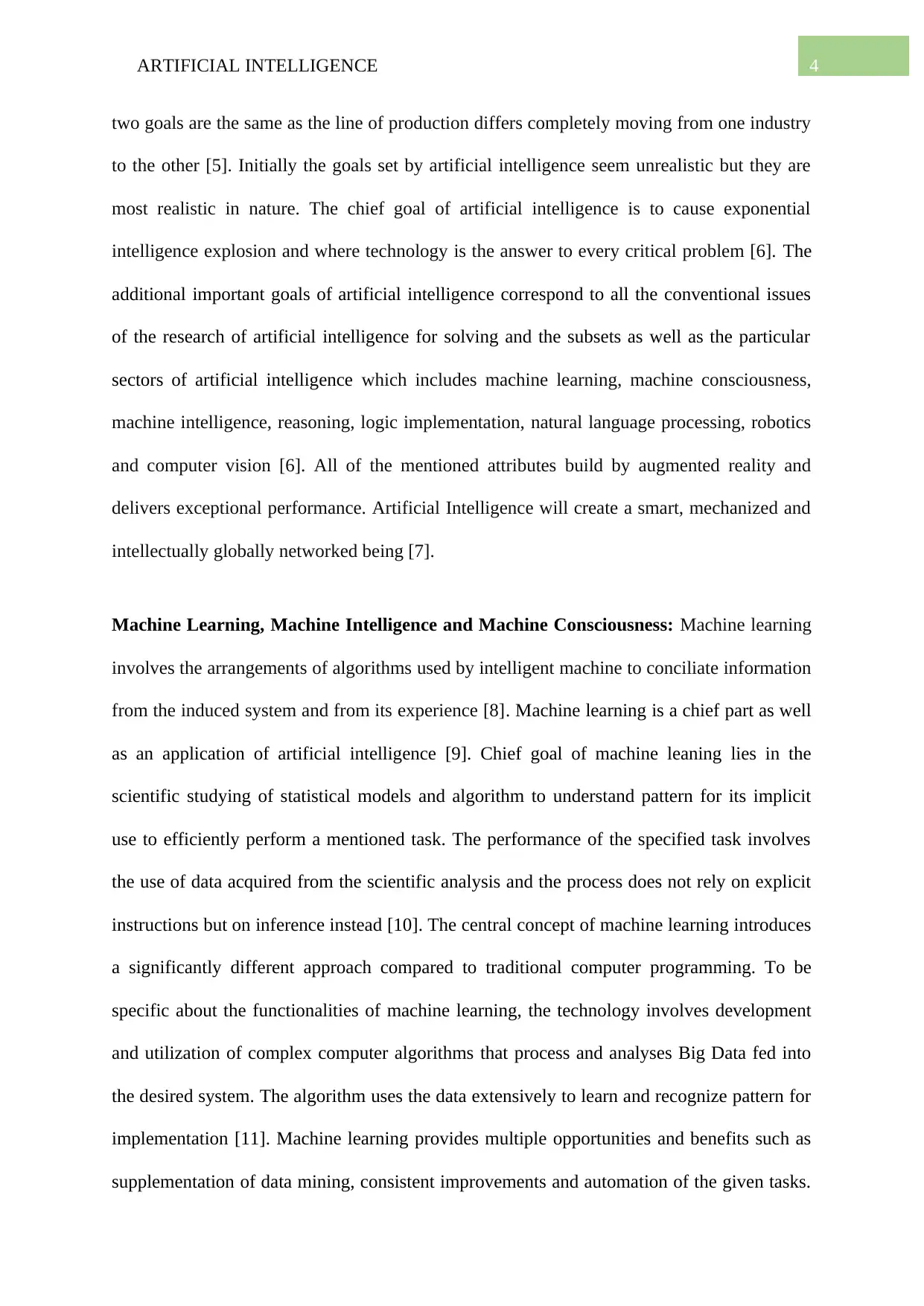
4ARTIFICIAL INTELLIGENCE
two goals are the same as the line of production differs completely moving from one industry
to the other [5]. Initially the goals set by artificial intelligence seem unrealistic but they are
most realistic in nature. The chief goal of artificial intelligence is to cause exponential
intelligence explosion and where technology is the answer to every critical problem [6]. The
additional important goals of artificial intelligence correspond to all the conventional issues
of the research of artificial intelligence for solving and the subsets as well as the particular
sectors of artificial intelligence which includes machine learning, machine consciousness,
machine intelligence, reasoning, logic implementation, natural language processing, robotics
and computer vision [6]. All of the mentioned attributes build by augmented reality and
delivers exceptional performance. Artificial Intelligence will create a smart, mechanized and
intellectually globally networked being [7].
Machine Learning, Machine Intelligence and Machine Consciousness: Machine learning
involves the arrangements of algorithms used by intelligent machine to conciliate information
from the induced system and from its experience [8]. Machine learning is a chief part as well
as an application of artificial intelligence [9]. Chief goal of machine leaning lies in the
scientific studying of statistical models and algorithm to understand pattern for its implicit
use to efficiently perform a mentioned task. The performance of the specified task involves
the use of data acquired from the scientific analysis and the process does not rely on explicit
instructions but on inference instead [10]. The central concept of machine learning introduces
a significantly different approach compared to traditional computer programming. To be
specific about the functionalities of machine learning, the technology involves development
and utilization of complex computer algorithms that process and analyses Big Data fed into
the desired system. The algorithm uses the data extensively to learn and recognize pattern for
implementation [11]. Machine learning provides multiple opportunities and benefits such as
supplementation of data mining, consistent improvements and automation of the given tasks.
two goals are the same as the line of production differs completely moving from one industry
to the other [5]. Initially the goals set by artificial intelligence seem unrealistic but they are
most realistic in nature. The chief goal of artificial intelligence is to cause exponential
intelligence explosion and where technology is the answer to every critical problem [6]. The
additional important goals of artificial intelligence correspond to all the conventional issues
of the research of artificial intelligence for solving and the subsets as well as the particular
sectors of artificial intelligence which includes machine learning, machine consciousness,
machine intelligence, reasoning, logic implementation, natural language processing, robotics
and computer vision [6]. All of the mentioned attributes build by augmented reality and
delivers exceptional performance. Artificial Intelligence will create a smart, mechanized and
intellectually globally networked being [7].
Machine Learning, Machine Intelligence and Machine Consciousness: Machine learning
involves the arrangements of algorithms used by intelligent machine to conciliate information
from the induced system and from its experience [8]. Machine learning is a chief part as well
as an application of artificial intelligence [9]. Chief goal of machine leaning lies in the
scientific studying of statistical models and algorithm to understand pattern for its implicit
use to efficiently perform a mentioned task. The performance of the specified task involves
the use of data acquired from the scientific analysis and the process does not rely on explicit
instructions but on inference instead [10]. The central concept of machine learning introduces
a significantly different approach compared to traditional computer programming. To be
specific about the functionalities of machine learning, the technology involves development
and utilization of complex computer algorithms that process and analyses Big Data fed into
the desired system. The algorithm uses the data extensively to learn and recognize pattern for
implementation [11]. Machine learning provides multiple opportunities and benefits such as
supplementation of data mining, consistent improvements and automation of the given tasks.
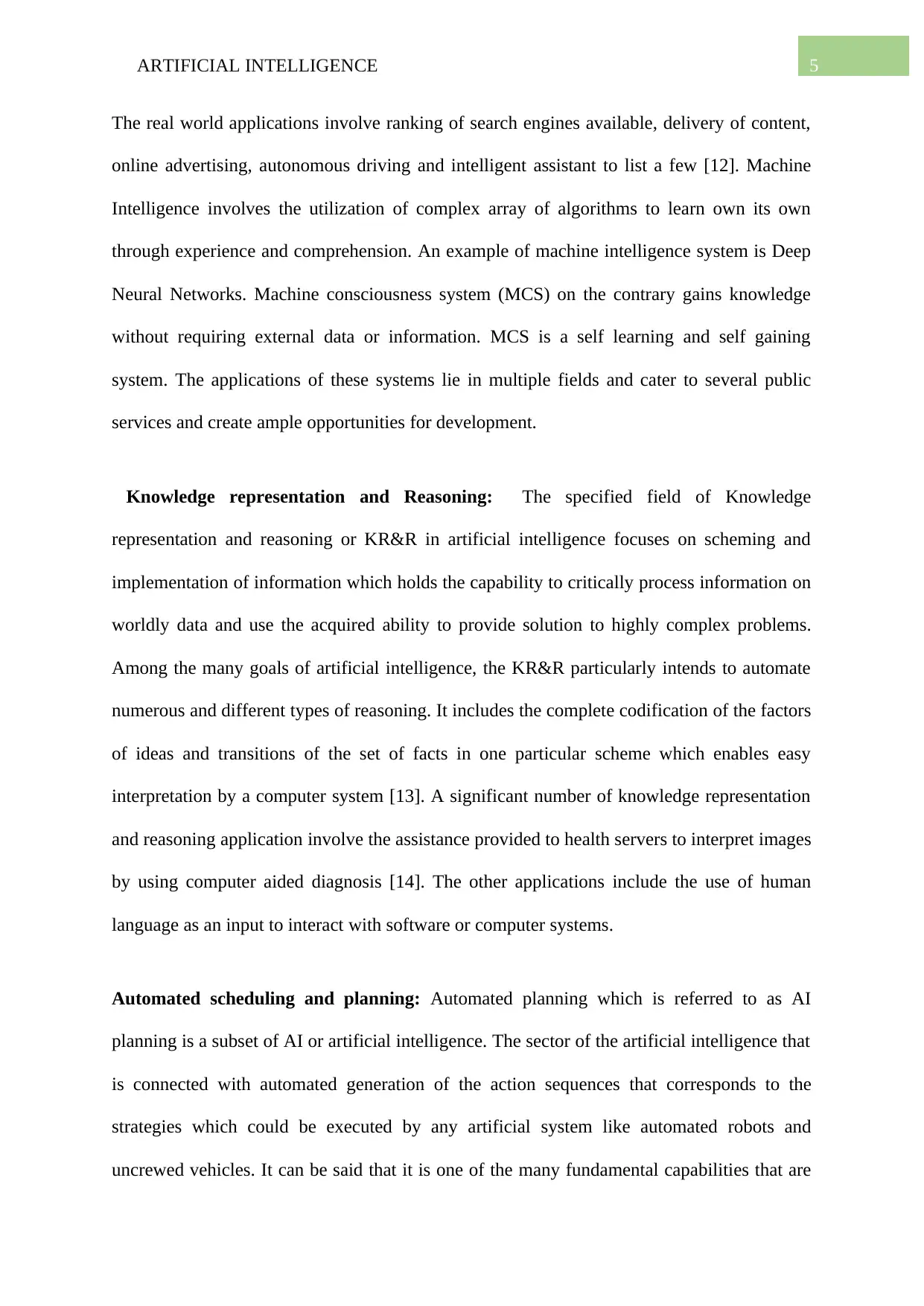
5ARTIFICIAL INTELLIGENCE
The real world applications involve ranking of search engines available, delivery of content,
online advertising, autonomous driving and intelligent assistant to list a few [12]. Machine
Intelligence involves the utilization of complex array of algorithms to learn own its own
through experience and comprehension. An example of machine intelligence system is Deep
Neural Networks. Machine consciousness system (MCS) on the contrary gains knowledge
without requiring external data or information. MCS is a self learning and self gaining
system. The applications of these systems lie in multiple fields and cater to several public
services and create ample opportunities for development.
Knowledge representation and Reasoning: The specified field of Knowledge
representation and reasoning or KR&R in artificial intelligence focuses on scheming and
implementation of information which holds the capability to critically process information on
worldly data and use the acquired ability to provide solution to highly complex problems.
Among the many goals of artificial intelligence, the KR&R particularly intends to automate
numerous and different types of reasoning. It includes the complete codification of the factors
of ideas and transitions of the set of facts in one particular scheme which enables easy
interpretation by a computer system [13]. A significant number of knowledge representation
and reasoning application involve the assistance provided to health servers to interpret images
by using computer aided diagnosis [14]. The other applications include the use of human
language as an input to interact with software or computer systems.
Automated scheduling and planning: Automated planning which is referred to as AI
planning is a subset of AI or artificial intelligence. The sector of the artificial intelligence that
is connected with automated generation of the action sequences that corresponds to the
strategies which could be executed by any artificial system like automated robots and
uncrewed vehicles. It can be said that it is one of the many fundamental capabilities that are
The real world applications involve ranking of search engines available, delivery of content,
online advertising, autonomous driving and intelligent assistant to list a few [12]. Machine
Intelligence involves the utilization of complex array of algorithms to learn own its own
through experience and comprehension. An example of machine intelligence system is Deep
Neural Networks. Machine consciousness system (MCS) on the contrary gains knowledge
without requiring external data or information. MCS is a self learning and self gaining
system. The applications of these systems lie in multiple fields and cater to several public
services and create ample opportunities for development.
Knowledge representation and Reasoning: The specified field of Knowledge
representation and reasoning or KR&R in artificial intelligence focuses on scheming and
implementation of information which holds the capability to critically process information on
worldly data and use the acquired ability to provide solution to highly complex problems.
Among the many goals of artificial intelligence, the KR&R particularly intends to automate
numerous and different types of reasoning. It includes the complete codification of the factors
of ideas and transitions of the set of facts in one particular scheme which enables easy
interpretation by a computer system [13]. A significant number of knowledge representation
and reasoning application involve the assistance provided to health servers to interpret images
by using computer aided diagnosis [14]. The other applications include the use of human
language as an input to interact with software or computer systems.
Automated scheduling and planning: Automated planning which is referred to as AI
planning is a subset of AI or artificial intelligence. The sector of the artificial intelligence that
is connected with automated generation of the action sequences that corresponds to the
strategies which could be executed by any artificial system like automated robots and
uncrewed vehicles. It can be said that it is one of the many fundamental capabilities that are
⊘ This is a preview!⊘
Do you want full access?
Subscribe today to unlock all pages.

Trusted by 1+ million students worldwide
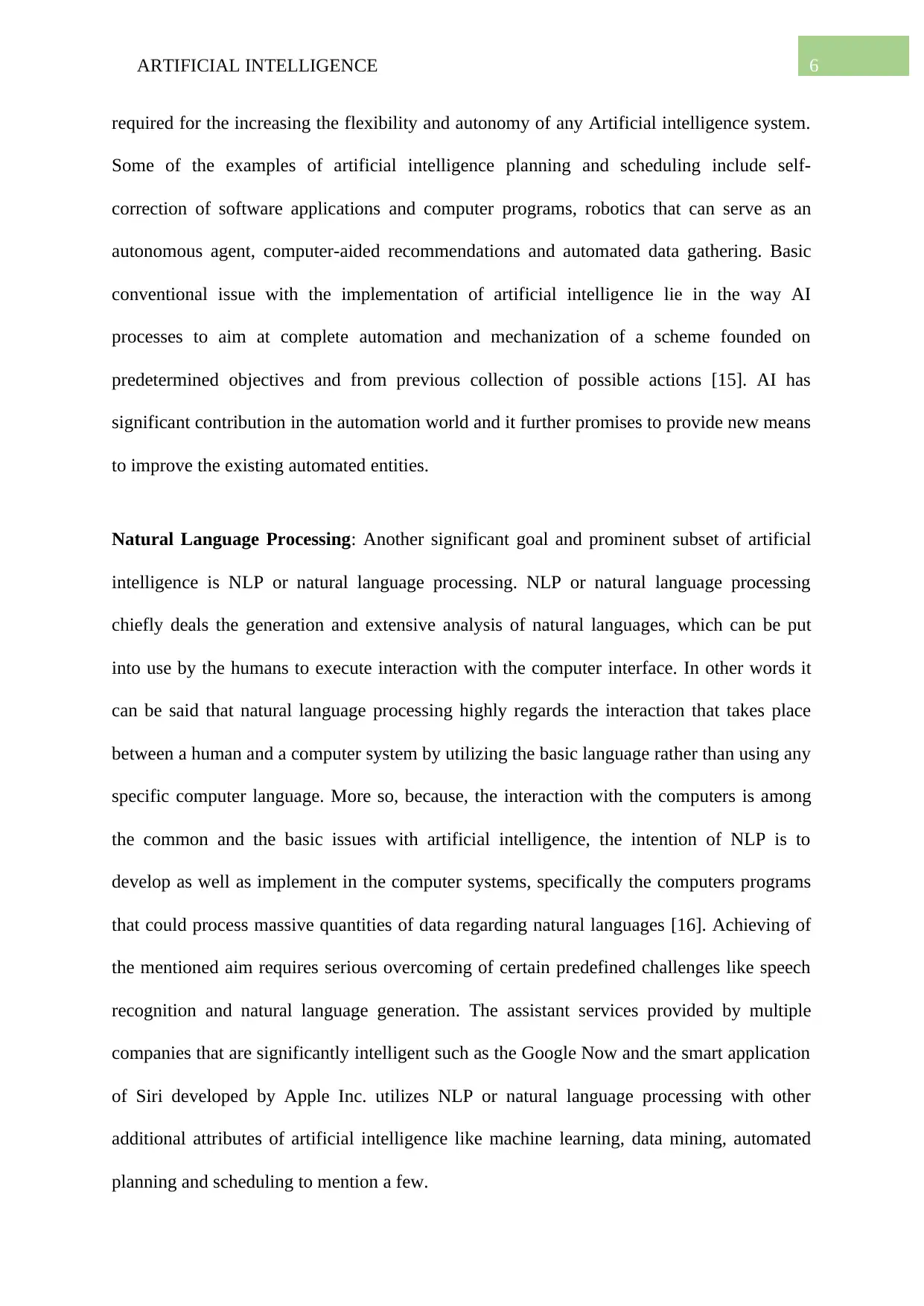
6ARTIFICIAL INTELLIGENCE
required for the increasing the flexibility and autonomy of any Artificial intelligence system.
Some of the examples of artificial intelligence planning and scheduling include self-
correction of software applications and computer programs, robotics that can serve as an
autonomous agent, computer-aided recommendations and automated data gathering. Basic
conventional issue with the implementation of artificial intelligence lie in the way AI
processes to aim at complete automation and mechanization of a scheme founded on
predetermined objectives and from previous collection of possible actions [15]. AI has
significant contribution in the automation world and it further promises to provide new means
to improve the existing automated entities.
Natural Language Processing: Another significant goal and prominent subset of artificial
intelligence is NLP or natural language processing. NLP or natural language processing
chiefly deals the generation and extensive analysis of natural languages, which can be put
into use by the humans to execute interaction with the computer interface. In other words it
can be said that natural language processing highly regards the interaction that takes place
between a human and a computer system by utilizing the basic language rather than using any
specific computer language. More so, because, the interaction with the computers is among
the common and the basic issues with artificial intelligence, the intention of NLP is to
develop as well as implement in the computer systems, specifically the computers programs
that could process massive quantities of data regarding natural languages [16]. Achieving of
the mentioned aim requires serious overcoming of certain predefined challenges like speech
recognition and natural language generation. The assistant services provided by multiple
companies that are significantly intelligent such as the Google Now and the smart application
of Siri developed by Apple Inc. utilizes NLP or natural language processing with other
additional attributes of artificial intelligence like machine learning, data mining, automated
planning and scheduling to mention a few.
required for the increasing the flexibility and autonomy of any Artificial intelligence system.
Some of the examples of artificial intelligence planning and scheduling include self-
correction of software applications and computer programs, robotics that can serve as an
autonomous agent, computer-aided recommendations and automated data gathering. Basic
conventional issue with the implementation of artificial intelligence lie in the way AI
processes to aim at complete automation and mechanization of a scheme founded on
predetermined objectives and from previous collection of possible actions [15]. AI has
significant contribution in the automation world and it further promises to provide new means
to improve the existing automated entities.
Natural Language Processing: Another significant goal and prominent subset of artificial
intelligence is NLP or natural language processing. NLP or natural language processing
chiefly deals the generation and extensive analysis of natural languages, which can be put
into use by the humans to execute interaction with the computer interface. In other words it
can be said that natural language processing highly regards the interaction that takes place
between a human and a computer system by utilizing the basic language rather than using any
specific computer language. More so, because, the interaction with the computers is among
the common and the basic issues with artificial intelligence, the intention of NLP is to
develop as well as implement in the computer systems, specifically the computers programs
that could process massive quantities of data regarding natural languages [16]. Achieving of
the mentioned aim requires serious overcoming of certain predefined challenges like speech
recognition and natural language generation. The assistant services provided by multiple
companies that are significantly intelligent such as the Google Now and the smart application
of Siri developed by Apple Inc. utilizes NLP or natural language processing with other
additional attributes of artificial intelligence like machine learning, data mining, automated
planning and scheduling to mention a few.
Paraphrase This Document
Need a fresh take? Get an instant paraphrase of this document with our AI Paraphraser
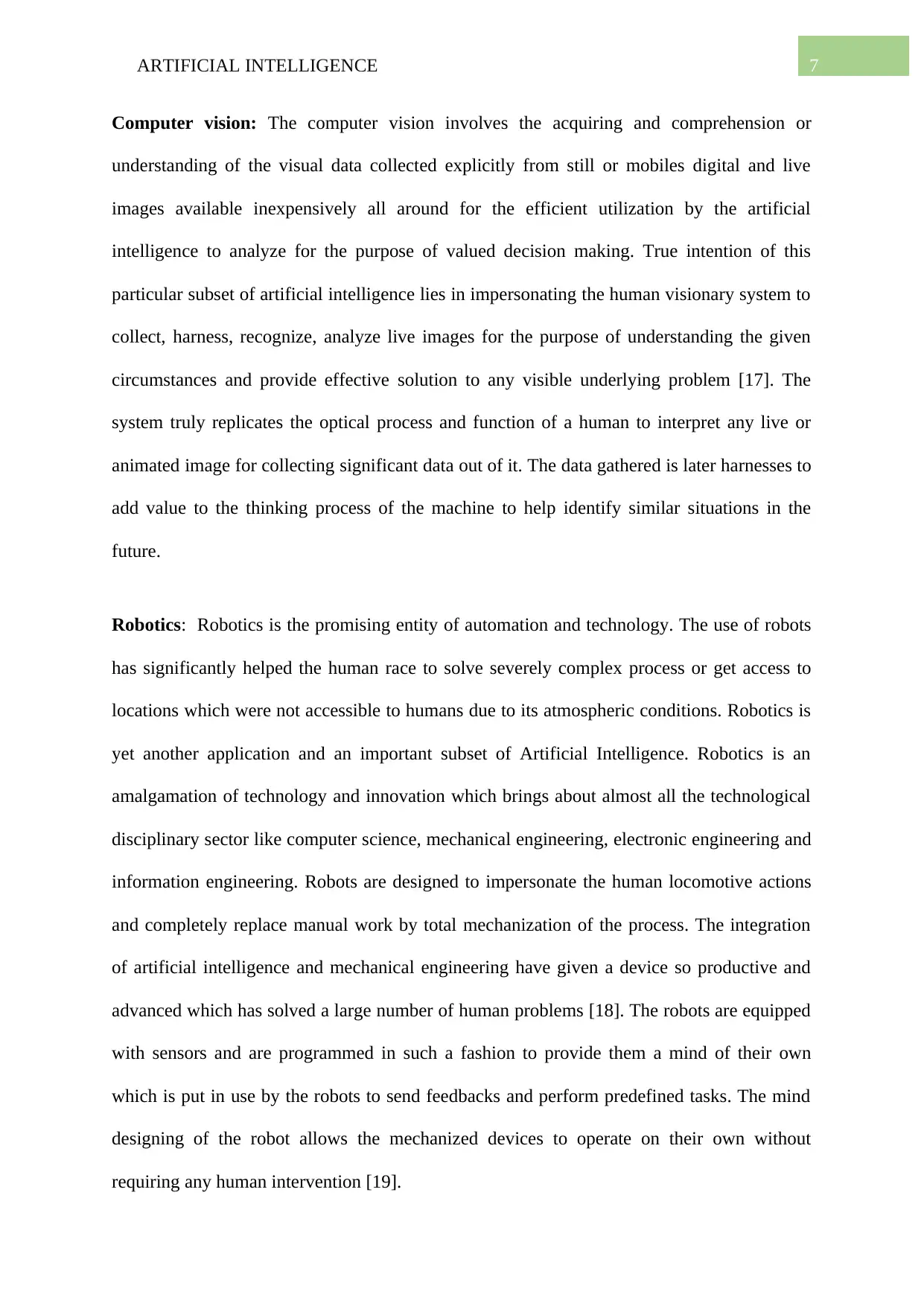
7ARTIFICIAL INTELLIGENCE
Computer vision: The computer vision involves the acquiring and comprehension or
understanding of the visual data collected explicitly from still or mobiles digital and live
images available inexpensively all around for the efficient utilization by the artificial
intelligence to analyze for the purpose of valued decision making. True intention of this
particular subset of artificial intelligence lies in impersonating the human visionary system to
collect, harness, recognize, analyze live images for the purpose of understanding the given
circumstances and provide effective solution to any visible underlying problem [17]. The
system truly replicates the optical process and function of a human to interpret any live or
animated image for collecting significant data out of it. The data gathered is later harnesses to
add value to the thinking process of the machine to help identify similar situations in the
future.
Robotics: Robotics is the promising entity of automation and technology. The use of robots
has significantly helped the human race to solve severely complex process or get access to
locations which were not accessible to humans due to its atmospheric conditions. Robotics is
yet another application and an important subset of Artificial Intelligence. Robotics is an
amalgamation of technology and innovation which brings about almost all the technological
disciplinary sector like computer science, mechanical engineering, electronic engineering and
information engineering. Robots are designed to impersonate the human locomotive actions
and completely replace manual work by total mechanization of the process. The integration
of artificial intelligence and mechanical engineering have given a device so productive and
advanced which has solved a large number of human problems [18]. The robots are equipped
with sensors and are programmed in such a fashion to provide them a mind of their own
which is put in use by the robots to send feedbacks and perform predefined tasks. The mind
designing of the robot allows the mechanized devices to operate on their own without
requiring any human intervention [19].
Computer vision: The computer vision involves the acquiring and comprehension or
understanding of the visual data collected explicitly from still or mobiles digital and live
images available inexpensively all around for the efficient utilization by the artificial
intelligence to analyze for the purpose of valued decision making. True intention of this
particular subset of artificial intelligence lies in impersonating the human visionary system to
collect, harness, recognize, analyze live images for the purpose of understanding the given
circumstances and provide effective solution to any visible underlying problem [17]. The
system truly replicates the optical process and function of a human to interpret any live or
animated image for collecting significant data out of it. The data gathered is later harnesses to
add value to the thinking process of the machine to help identify similar situations in the
future.
Robotics: Robotics is the promising entity of automation and technology. The use of robots
has significantly helped the human race to solve severely complex process or get access to
locations which were not accessible to humans due to its atmospheric conditions. Robotics is
yet another application and an important subset of Artificial Intelligence. Robotics is an
amalgamation of technology and innovation which brings about almost all the technological
disciplinary sector like computer science, mechanical engineering, electronic engineering and
information engineering. Robots are designed to impersonate the human locomotive actions
and completely replace manual work by total mechanization of the process. The integration
of artificial intelligence and mechanical engineering have given a device so productive and
advanced which has solved a large number of human problems [18]. The robots are equipped
with sensors and are programmed in such a fashion to provide them a mind of their own
which is put in use by the robots to send feedbacks and perform predefined tasks. The mind
designing of the robot allows the mechanized devices to operate on their own without
requiring any human intervention [19].
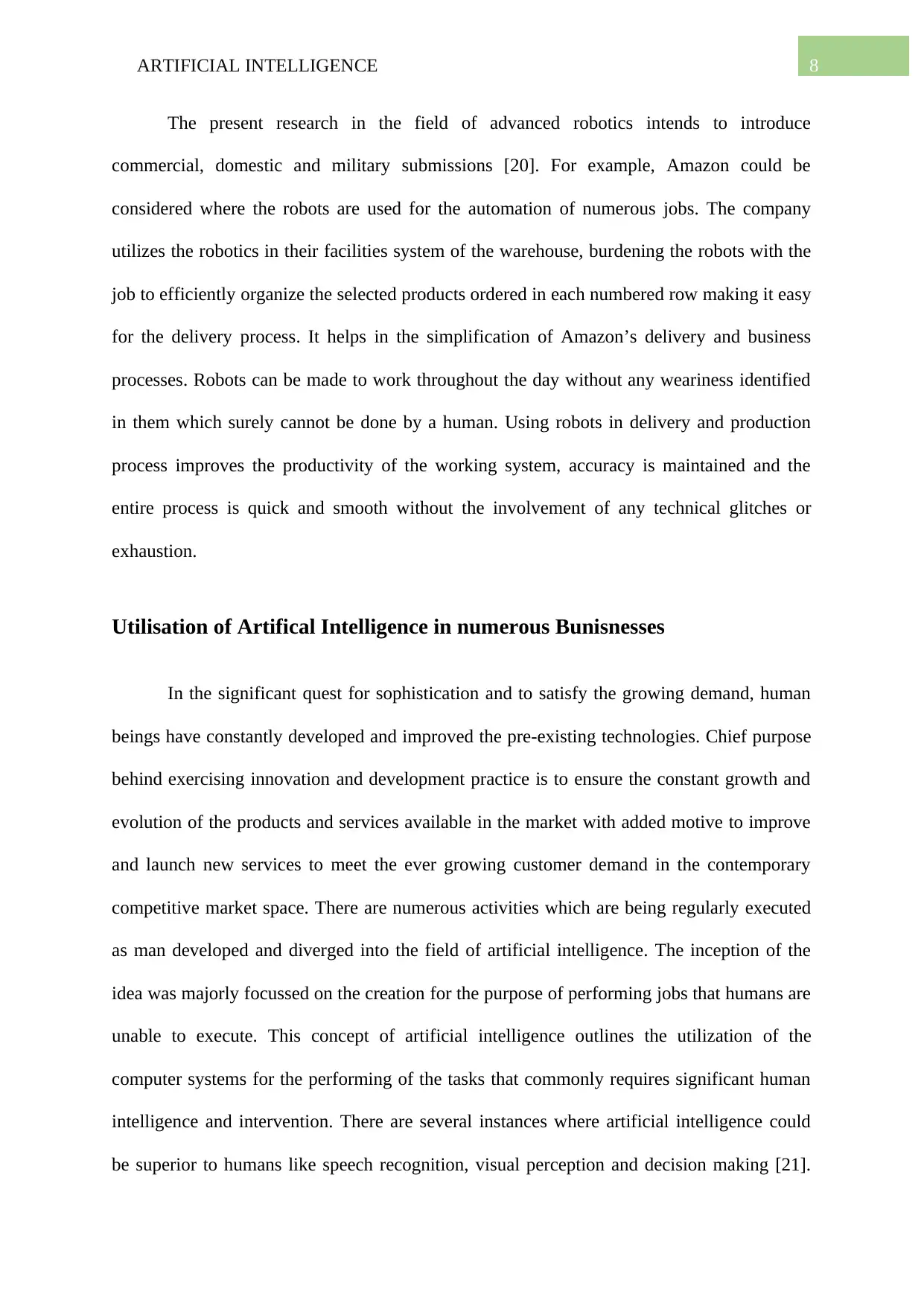
8ARTIFICIAL INTELLIGENCE
The present research in the field of advanced robotics intends to introduce
commercial, domestic and military submissions [20]. For example, Amazon could be
considered where the robots are used for the automation of numerous jobs. The company
utilizes the robotics in their facilities system of the warehouse, burdening the robots with the
job to efficiently organize the selected products ordered in each numbered row making it easy
for the delivery process. It helps in the simplification of Amazon’s delivery and business
processes. Robots can be made to work throughout the day without any weariness identified
in them which surely cannot be done by a human. Using robots in delivery and production
process improves the productivity of the working system, accuracy is maintained and the
entire process is quick and smooth without the involvement of any technical glitches or
exhaustion.
Utilisation of Artifical Intelligence in numerous Bunisnesses
In the significant quest for sophistication and to satisfy the growing demand, human
beings have constantly developed and improved the pre-existing technologies. Chief purpose
behind exercising innovation and development practice is to ensure the constant growth and
evolution of the products and services available in the market with added motive to improve
and launch new services to meet the ever growing customer demand in the contemporary
competitive market space. There are numerous activities which are being regularly executed
as man developed and diverged into the field of artificial intelligence. The inception of the
idea was majorly focussed on the creation for the purpose of performing jobs that humans are
unable to execute. This concept of artificial intelligence outlines the utilization of the
computer systems for the performing of the tasks that commonly requires significant human
intelligence and intervention. There are several instances where artificial intelligence could
be superior to humans like speech recognition, visual perception and decision making [21].
The present research in the field of advanced robotics intends to introduce
commercial, domestic and military submissions [20]. For example, Amazon could be
considered where the robots are used for the automation of numerous jobs. The company
utilizes the robotics in their facilities system of the warehouse, burdening the robots with the
job to efficiently organize the selected products ordered in each numbered row making it easy
for the delivery process. It helps in the simplification of Amazon’s delivery and business
processes. Robots can be made to work throughout the day without any weariness identified
in them which surely cannot be done by a human. Using robots in delivery and production
process improves the productivity of the working system, accuracy is maintained and the
entire process is quick and smooth without the involvement of any technical glitches or
exhaustion.
Utilisation of Artifical Intelligence in numerous Bunisnesses
In the significant quest for sophistication and to satisfy the growing demand, human
beings have constantly developed and improved the pre-existing technologies. Chief purpose
behind exercising innovation and development practice is to ensure the constant growth and
evolution of the products and services available in the market with added motive to improve
and launch new services to meet the ever growing customer demand in the contemporary
competitive market space. There are numerous activities which are being regularly executed
as man developed and diverged into the field of artificial intelligence. The inception of the
idea was majorly focussed on the creation for the purpose of performing jobs that humans are
unable to execute. This concept of artificial intelligence outlines the utilization of the
computer systems for the performing of the tasks that commonly requires significant human
intelligence and intervention. There are several instances where artificial intelligence could
be superior to humans like speech recognition, visual perception and decision making [21].
⊘ This is a preview!⊘
Do you want full access?
Subscribe today to unlock all pages.

Trusted by 1+ million students worldwide
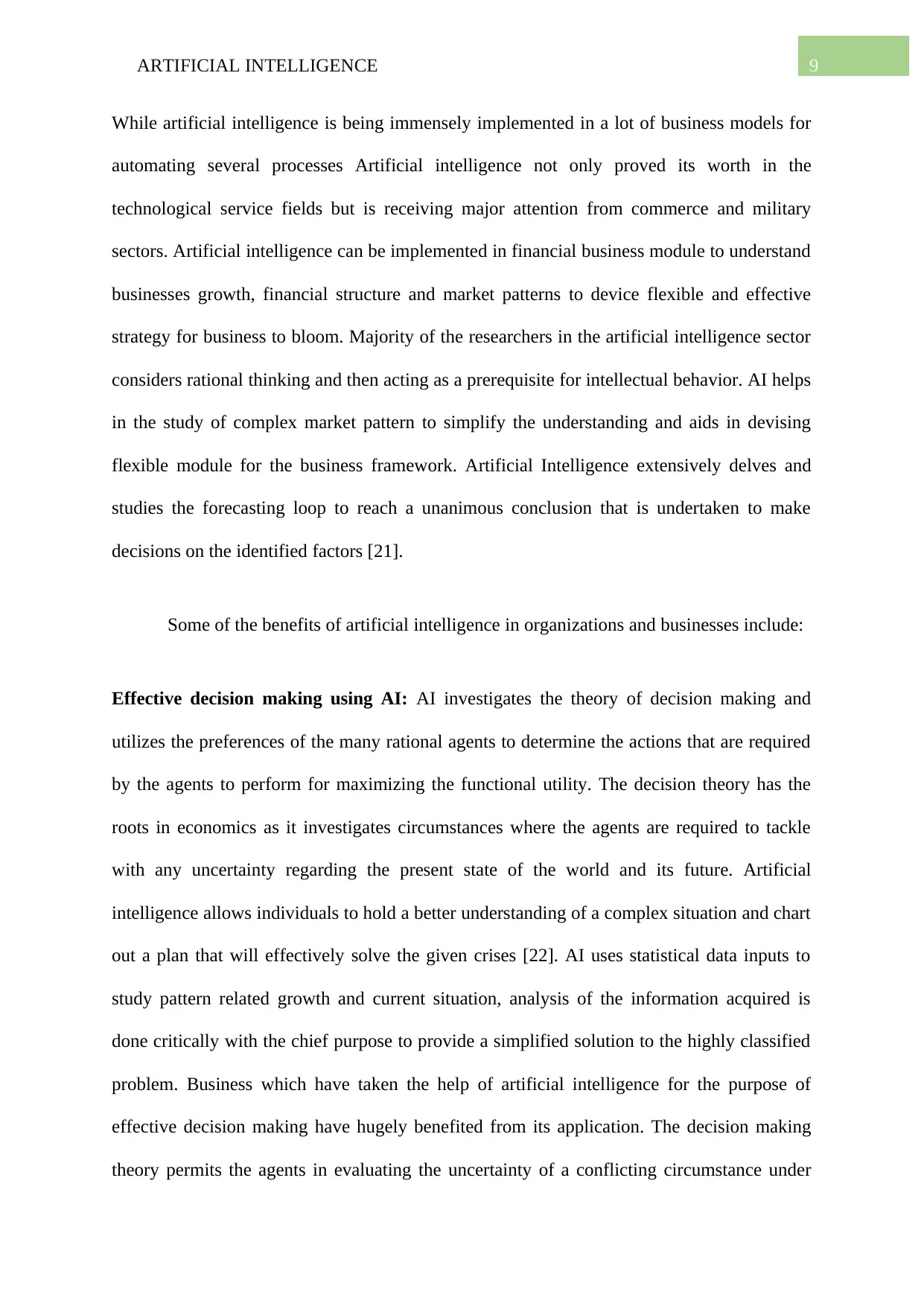
9ARTIFICIAL INTELLIGENCE
While artificial intelligence is being immensely implemented in a lot of business models for
automating several processes Artificial intelligence not only proved its worth in the
technological service fields but is receiving major attention from commerce and military
sectors. Artificial intelligence can be implemented in financial business module to understand
businesses growth, financial structure and market patterns to device flexible and effective
strategy for business to bloom. Majority of the researchers in the artificial intelligence sector
considers rational thinking and then acting as a prerequisite for intellectual behavior. AI helps
in the study of complex market pattern to simplify the understanding and aids in devising
flexible module for the business framework. Artificial Intelligence extensively delves and
studies the forecasting loop to reach a unanimous conclusion that is undertaken to make
decisions on the identified factors [21].
Some of the benefits of artificial intelligence in organizations and businesses include:
Effective decision making using AI: AI investigates the theory of decision making and
utilizes the preferences of the many rational agents to determine the actions that are required
by the agents to perform for maximizing the functional utility. The decision theory has the
roots in economics as it investigates circumstances where the agents are required to tackle
with any uncertainty regarding the present state of the world and its future. Artificial
intelligence allows individuals to hold a better understanding of a complex situation and chart
out a plan that will effectively solve the given crises [22]. AI uses statistical data inputs to
study pattern related growth and current situation, analysis of the information acquired is
done critically with the chief purpose to provide a simplified solution to the highly classified
problem. Business which have taken the help of artificial intelligence for the purpose of
effective decision making have hugely benefited from its application. The decision making
theory permits the agents in evaluating the uncertainty of a conflicting circumstance under
While artificial intelligence is being immensely implemented in a lot of business models for
automating several processes Artificial intelligence not only proved its worth in the
technological service fields but is receiving major attention from commerce and military
sectors. Artificial intelligence can be implemented in financial business module to understand
businesses growth, financial structure and market patterns to device flexible and effective
strategy for business to bloom. Majority of the researchers in the artificial intelligence sector
considers rational thinking and then acting as a prerequisite for intellectual behavior. AI helps
in the study of complex market pattern to simplify the understanding and aids in devising
flexible module for the business framework. Artificial Intelligence extensively delves and
studies the forecasting loop to reach a unanimous conclusion that is undertaken to make
decisions on the identified factors [21].
Some of the benefits of artificial intelligence in organizations and businesses include:
Effective decision making using AI: AI investigates the theory of decision making and
utilizes the preferences of the many rational agents to determine the actions that are required
by the agents to perform for maximizing the functional utility. The decision theory has the
roots in economics as it investigates circumstances where the agents are required to tackle
with any uncertainty regarding the present state of the world and its future. Artificial
intelligence allows individuals to hold a better understanding of a complex situation and chart
out a plan that will effectively solve the given crises [22]. AI uses statistical data inputs to
study pattern related growth and current situation, analysis of the information acquired is
done critically with the chief purpose to provide a simplified solution to the highly classified
problem. Business which have taken the help of artificial intelligence for the purpose of
effective decision making have hugely benefited from its application. The decision making
theory permits the agents in evaluating the uncertainty of a conflicting circumstance under
Paraphrase This Document
Need a fresh take? Get an instant paraphrase of this document with our AI Paraphraser
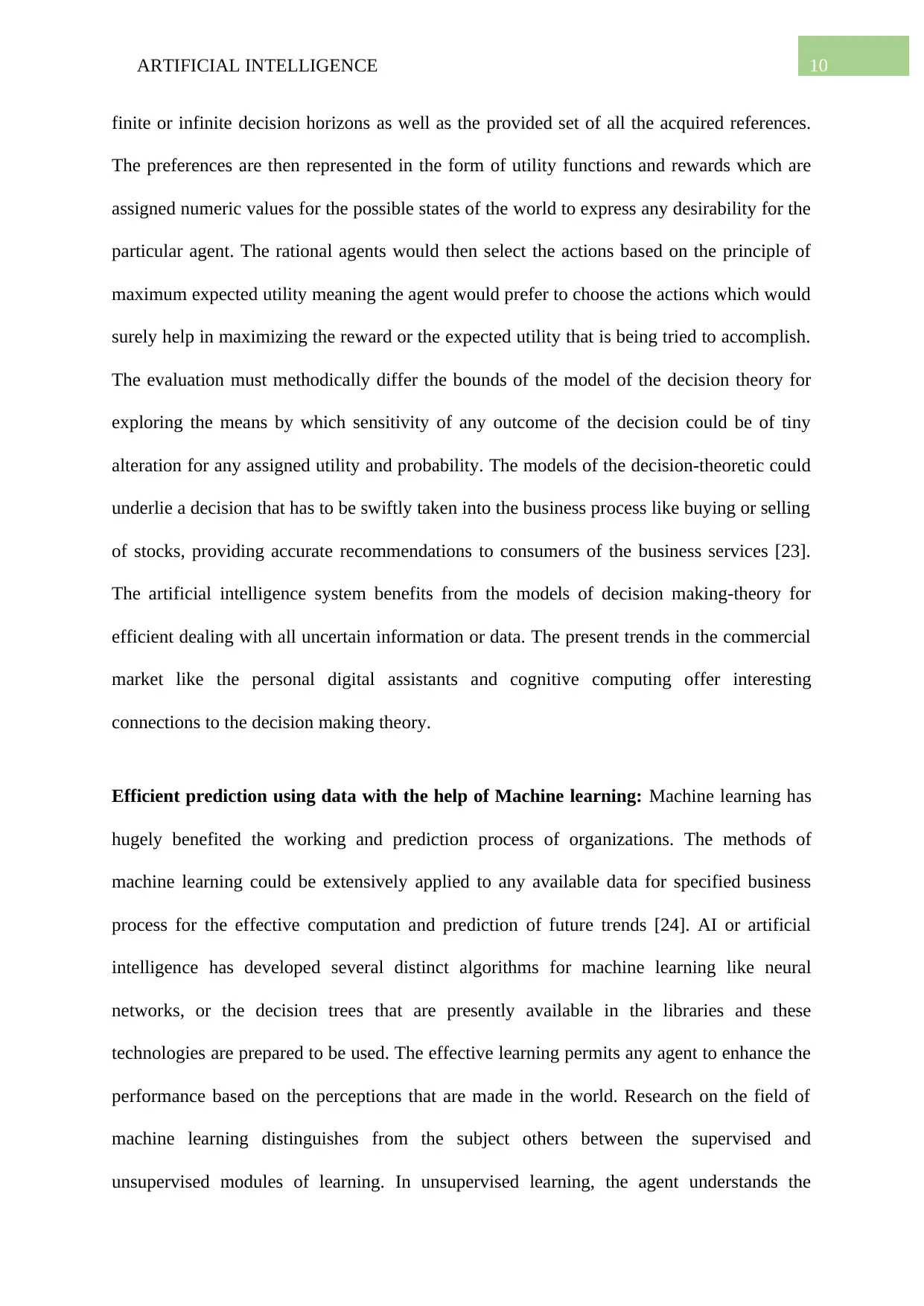
10ARTIFICIAL INTELLIGENCE
finite or infinite decision horizons as well as the provided set of all the acquired references.
The preferences are then represented in the form of utility functions and rewards which are
assigned numeric values for the possible states of the world to express any desirability for the
particular agent. The rational agents would then select the actions based on the principle of
maximum expected utility meaning the agent would prefer to choose the actions which would
surely help in maximizing the reward or the expected utility that is being tried to accomplish.
The evaluation must methodically differ the bounds of the model of the decision theory for
exploring the means by which sensitivity of any outcome of the decision could be of tiny
alteration for any assigned utility and probability. The models of the decision-theoretic could
underlie a decision that has to be swiftly taken into the business process like buying or selling
of stocks, providing accurate recommendations to consumers of the business services [23].
The artificial intelligence system benefits from the models of decision making-theory for
efficient dealing with all uncertain information or data. The present trends in the commercial
market like the personal digital assistants and cognitive computing offer interesting
connections to the decision making theory.
Efficient prediction using data with the help of Machine learning: Machine learning has
hugely benefited the working and prediction process of organizations. The methods of
machine learning could be extensively applied to any available data for specified business
process for the effective computation and prediction of future trends [24]. AI or artificial
intelligence has developed several distinct algorithms for machine learning like neural
networks, or the decision trees that are presently available in the libraries and these
technologies are prepared to be used. The effective learning permits any agent to enhance the
performance based on the perceptions that are made in the world. Research on the field of
machine learning distinguishes from the subject others between the supervised and
unsupervised modules of learning. In unsupervised learning, the agent understands the
finite or infinite decision horizons as well as the provided set of all the acquired references.
The preferences are then represented in the form of utility functions and rewards which are
assigned numeric values for the possible states of the world to express any desirability for the
particular agent. The rational agents would then select the actions based on the principle of
maximum expected utility meaning the agent would prefer to choose the actions which would
surely help in maximizing the reward or the expected utility that is being tried to accomplish.
The evaluation must methodically differ the bounds of the model of the decision theory for
exploring the means by which sensitivity of any outcome of the decision could be of tiny
alteration for any assigned utility and probability. The models of the decision-theoretic could
underlie a decision that has to be swiftly taken into the business process like buying or selling
of stocks, providing accurate recommendations to consumers of the business services [23].
The artificial intelligence system benefits from the models of decision making-theory for
efficient dealing with all uncertain information or data. The present trends in the commercial
market like the personal digital assistants and cognitive computing offer interesting
connections to the decision making theory.
Efficient prediction using data with the help of Machine learning: Machine learning has
hugely benefited the working and prediction process of organizations. The methods of
machine learning could be extensively applied to any available data for specified business
process for the effective computation and prediction of future trends [24]. AI or artificial
intelligence has developed several distinct algorithms for machine learning like neural
networks, or the decision trees that are presently available in the libraries and these
technologies are prepared to be used. The effective learning permits any agent to enhance the
performance based on the perceptions that are made in the world. Research on the field of
machine learning distinguishes from the subject others between the supervised and
unsupervised modules of learning. In unsupervised learning, the agent understands the
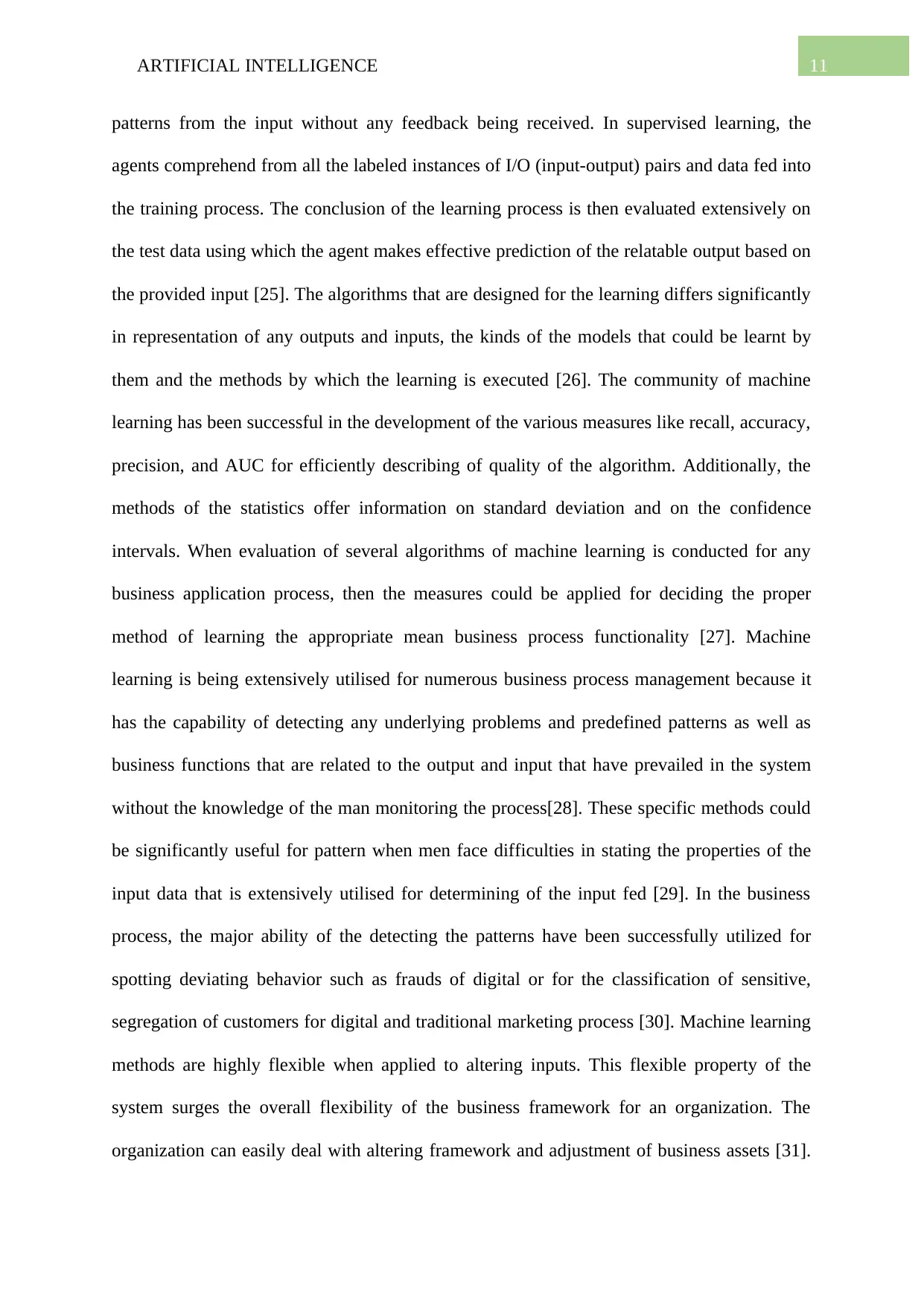
11ARTIFICIAL INTELLIGENCE
patterns from the input without any feedback being received. In supervised learning, the
agents comprehend from all the labeled instances of I/O (input-output) pairs and data fed into
the training process. The conclusion of the learning process is then evaluated extensively on
the test data using which the agent makes effective prediction of the relatable output based on
the provided input [25]. The algorithms that are designed for the learning differs significantly
in representation of any outputs and inputs, the kinds of the models that could be learnt by
them and the methods by which the learning is executed [26]. The community of machine
learning has been successful in the development of the various measures like recall, accuracy,
precision, and AUC for efficiently describing of quality of the algorithm. Additionally, the
methods of the statistics offer information on standard deviation and on the confidence
intervals. When evaluation of several algorithms of machine learning is conducted for any
business application process, then the measures could be applied for deciding the proper
method of learning the appropriate mean business process functionality [27]. Machine
learning is being extensively utilised for numerous business process management because it
has the capability of detecting any underlying problems and predefined patterns as well as
business functions that are related to the output and input that have prevailed in the system
without the knowledge of the man monitoring the process[28]. These specific methods could
be significantly useful for pattern when men face difficulties in stating the properties of the
input data that is extensively utilised for determining of the input fed [29]. In the business
process, the major ability of the detecting the patterns have been successfully utilized for
spotting deviating behavior such as frauds of digital or for the classification of sensitive,
segregation of customers for digital and traditional marketing process [30]. Machine learning
methods are highly flexible when applied to altering inputs. This flexible property of the
system surges the overall flexibility of the business framework for an organization. The
organization can easily deal with altering framework and adjustment of business assets [31].
patterns from the input without any feedback being received. In supervised learning, the
agents comprehend from all the labeled instances of I/O (input-output) pairs and data fed into
the training process. The conclusion of the learning process is then evaluated extensively on
the test data using which the agent makes effective prediction of the relatable output based on
the provided input [25]. The algorithms that are designed for the learning differs significantly
in representation of any outputs and inputs, the kinds of the models that could be learnt by
them and the methods by which the learning is executed [26]. The community of machine
learning has been successful in the development of the various measures like recall, accuracy,
precision, and AUC for efficiently describing of quality of the algorithm. Additionally, the
methods of the statistics offer information on standard deviation and on the confidence
intervals. When evaluation of several algorithms of machine learning is conducted for any
business application process, then the measures could be applied for deciding the proper
method of learning the appropriate mean business process functionality [27]. Machine
learning is being extensively utilised for numerous business process management because it
has the capability of detecting any underlying problems and predefined patterns as well as
business functions that are related to the output and input that have prevailed in the system
without the knowledge of the man monitoring the process[28]. These specific methods could
be significantly useful for pattern when men face difficulties in stating the properties of the
input data that is extensively utilised for determining of the input fed [29]. In the business
process, the major ability of the detecting the patterns have been successfully utilized for
spotting deviating behavior such as frauds of digital or for the classification of sensitive,
segregation of customers for digital and traditional marketing process [30]. Machine learning
methods are highly flexible when applied to altering inputs. This flexible property of the
system surges the overall flexibility of the business framework for an organization. The
organization can easily deal with altering framework and adjustment of business assets [31].
⊘ This is a preview!⊘
Do you want full access?
Subscribe today to unlock all pages.

Trusted by 1+ million students worldwide
1 out of 24
Related Documents
Your All-in-One AI-Powered Toolkit for Academic Success.
+13062052269
info@desklib.com
Available 24*7 on WhatsApp / Email
![[object Object]](/_next/static/media/star-bottom.7253800d.svg)
Unlock your academic potential
Copyright © 2020–2025 A2Z Services. All Rights Reserved. Developed and managed by ZUCOL.





